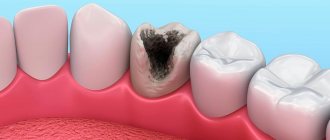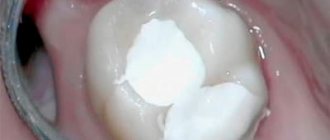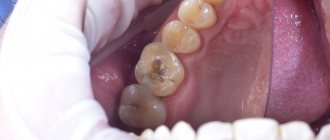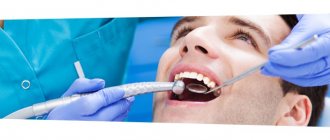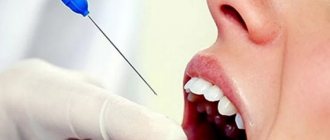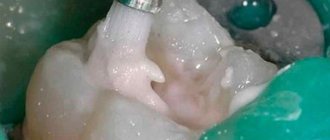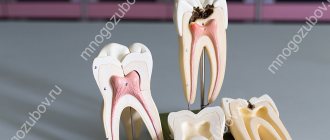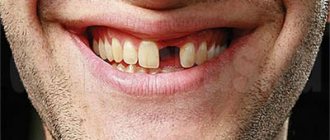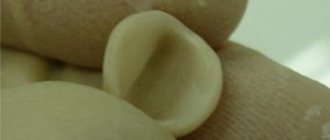Indications
The cavity located inside the tooth, where the nerve endings and blood vessels are located, is called the pulp. If the caries lesion is not treated in a timely manner, the pathology reaches the pulp, which leads to the occurrence of an inflammatory process called pulpitis. The process does not go away on its own; the pain that inevitably arises is removed by painkillers in the initial stages. Over time, they also stop working. In advanced cases, inflammation spreads to the bone, which leads to periodontitis and, as a consequence, osteomyelitis. The main indication for root canal filling is pulpitis caused by caries.
When is endodontic intervention indicated?
Endodontic treatment is carried out in the following cases:
- Inflammation of the coronal and root pulp - pulpitis. Moreover, the form of the disease can be both acute and chronic.
- Periodontitis.
Inflammation of blood vessels and nerve fibers is observed in complicated forms of caries, with a cracked tooth. Inflammation can also be a consequence of injury.
Are there any contraindications for this procedure?
Like any dental procedure, endodontics is contraindicated in a number of cases:
- Vertical incisor fracture.
- Too narrow, impassable dental canals.
- Damage to periodontal tissue.
Filling methods
Until recently, the procedure was carried out using pastes, which are inexpensive and do not require complex technologies. Now professional dentists have abandoned them due to insufficient fluidity, which leads to the formation of cavities. Voids lead to depressurization and relapse of inflammation.
At the moment, doctors choose progressive methods:
- Thermophile system. The filling is performed with hot gutta-percha, which hardens as it cools. It is characterized by high plasticity. There is no pain after treatment. The risk of complications is minimal;
- depophoresis. It is used for filling difficult, curved canals, as well as for restoring elements from which it is difficult to remove old fillings and where fragments of ostomy instruments remain in the cavities. Efficiency - no less than 95%;
- E&Q Plus. The latest generation method, which provides various methods of filling the roots of one tooth. The injection gun heats the gutta-percha directly inside the cavity. The doctor can control the temperature of the material using the information display.
Another common method is filling the canals with cold gutta-percha, which is used in several ways:
- lateral condensation;
- softening due to chemical action;
- with one pin. To give the shape, a pin is installed in the canal. Sealing is ensured through the use of paste.
There are other technologies that are selected depending on the location of the channels, the condition of the tissues and the experience of the doctor.
How long does a temporary filling last?
Many patients are interested in how long can they walk with a temporary filling? Can it at least temporarily replace a permanent one, which costs more and requires another visit to the doctor?
Temporary tabs are different. This will determine how much it costs. The most short-lived ones isolate the oral cavity from arsenic, which is embedded in the pulp of the tooth. Typically, such treatment lasts for 2-3 days, and then it is necessary to change the temporary material to permanent one.
The service life of a temporary filling in the treatment of canals or periodontitis is slightly longer. You can use it for up to 2 months until inflammation and infection are completely eliminated. The doctor monitors the process using radiovisiography, a safe diagnostic method that has replaced x-rays in dental clinics.
A separate question is how many days a temporary filling is placed for prosthetics with massive non-removable structures? It all depends on the volume of work and timing, however, in most cases, temporary material will last the patient no more than a year.
If a patient has a temporary filling, how long after can he eat food so that it does not fall out? Usually you can eat it almost immediately, but it is worth remembering that temporary materials are very unreliable, so they can crumble and crumble under intense pressure on the tooth. This is normal and should not be a cause for concern.
Stages of canal filling
First of all, the doctor carries out an examination and the necessary diagnostic operations, which may include, for example, an X-ray examination of the oral cavity.
If suspicions about the need to fill the canal are confirmed, the dentist carries out preparatory manipulations. First of all, adequate anesthesia. After it has taken effect, the caries-affected tissue is removed using a burr. The dental nerve is then removed. Next, the doctor is engaged in mechanical processing of the endodont - a complex of dental tissues, including pulp and dentin.
Upon completion of the preparatory stage, the empty root canal is filled, then a permanent filling or crown is installed.
Reasons for the development of childhood caries
Main risk factors:
- Excessive consumption of sweets. In this case, a harmful environment is formed in the child’s mouth, and the tooth enamel begins to suffer.
- Transmission of infection from relatives. This can happen when sharing utensils, adults licking a baby's spoon, and sometimes even kissing.
- Long contact with the bottle. This type of caries is called “bottle caries”. If a baby drinks a sweet liquid from a bottle and then falls asleep with it, then prolonged contact of the sweet with the teeth can lead to the rapid development of caries.
- Deficiency of fluoride and calcium in food.
- Lack of solid food. When chewing solid food, a lot of saliva is released, which naturally washes the oral cavity.
- The use of medications that change the composition of saliva.
- Chronic diseases.
- Improper care of baby teeth. Infants need to wipe their teeth from the moment they erupt - you can use ordinary gauze wrapped around your finger. It is very important for parents to teach older children to brush their teeth and use a brush, constantly remind them of this and monitor compliance with the procedures. The example of parents is a strong motivating factor here.
Description of the procedure
- Local snapshot. X-ray allows you to see the condition of all channels, their number, location. In difficult cases, a 3D image is taken.
- Anesthesia.
- Drilling of diseased tooth tissues.
- Removal of nerve and blood vessels.
- Determining the depth of the canal using an apexolator.
- Widening the passage to place the drug and install the pin (if required).
- Filling.
- Control photo.
After treatment, it is not recommended to consume hot drinks and food for 1 – 2 hours.
Why does caries occur on young permanent teeth?
A teenager's permanent teeth have their own characteristics, and caries on them develops differently than on the teeth of an adult. That is why pediatric dentists treat caries in adolescents.
The fact is that a newly erupted tooth is vulnerable, since its mineralization remains low during the first year. Moreover, on molars and premolars, mineralization is finally completed only by 4-5 years after eruption. This is why the enamel on young permanent teeth of a teenager is still highly permeable, and the dentinal tubules are even wider than on baby teeth. As a result, the risk of caries is very high in the first year after eruption, and the rate of its development can be very fast.
Temporary filling
In some cases, medicine is introduced into the canals for a certain period of time. Manipulation is carried out for:
- elimination of pathological microflora;
- stopping the inflammatory process;
- isolation of the canal, when it is impossible to carry out treatment in one visit.
Indications for temporary installation of a filling are injuries, perforation of walls, periodontitis in acute or chronic form.
The main active components of medicinal non-hardening pastes are antibiotics.
Treatment of generalized pathological abrasion
Preparatory stage of the treatment stage for generalized pathological abrasion
During the preparatory stage of treatment of pathological abrasion, it is important to correctly determine the position of the lower jaw, eliminate its distal displacement and restore the height of the lower third of the face . At this stage, it is necessary to carry out x-ray diagnostics of the position of the elements of the mandibular joint.
Restoring lower facial height
To restore the height of the lower part of the face, dental aligners and provisional removable and fixed dentures are used. Distal displacement of the mandible is carried out using inclined aligners and inclined plates with bite pads.
During the process of abrasion, bone tissue is rebuilt and the alveolar process hypertrophies. Elimination of dentoalveolar elongation is carried out using orthodontic, surgical, hardware and combined methods.
Also, increased abrasion is often accompanied by a reaction from the pulp, degenerative processes in it, including sclerosis and deposition of calcifications. Therefore, with a pronounced loss of hard tissues of the tooth crown and the prevention of complications from the pulp in clinical situations, endodontic preparation of teeth and restoration of the core part of the tooth with pin structures may be necessary.
Permanent prosthetics for pathological abrasion
For permanent prosthetics in case of pathological abrasion, various types of crowns and inlays are used, and in case of defects in the dentition, bridges, structures on implants, clasp dentures and their combinations are also used. Also, with a small number of supporting teeth, it is advisable to use removable dentures with various types of locking fasteners and telescopic fixation.
When restoring teeth with increased abrasion, it is effective to use metal inlays, however, in an aesthetically important area, it is advisable to use combined metal-plastic and metal-ceramic inlays, as well as all-ceramic inlays.
Like inlays, it is advisable to make crowns for the chewing group of teeth made of cast metal, while the use of stamped structures is unacceptable, since they quickly wear out and become unusable. A compromise is the use of stamped crowns with cast metal guards.
The most successful from the point of view of aesthetics and function are combined structures with a cast metal frame and cladding made of plastic or ceramics. However, if the patient has parafunctions, chipping of the lining may occur. In this case, it is easier to restore metal-plastic structures.
In addition to orthopedic treatment, a medicinal method aimed at eliminating hyperesthesia and a therapeutic method that allows the restoration of lost hard tissue using composite materials can also be used. The method is quite effective; it requires sufficient skills of the dentist-therapist and competent motivation of the patient to achieve effective dynamic observation.
Bridges
In the treatment of increased abrasion, complicated by defects in the dentition, bridges are used. The principles of prosthetics with bridges are the same as with inlays and crowns, consisting in the effectiveness of using cast metal structures with ceramic or plastic lining to restore aesthetics.
Clasp dentures with occlusal overlays, which do not require preparation of the supporting teeth, are also effective. Sometimes correction of teeth is necessary, which consists of grinding off sharp edges to prevent them from chipping under the pressure of the clasp denture.
Surgery
If necessary, correction of dental deformations can resort to surgical treatment (correction of alveolar processes, removal of protruded teeth), shortening of teeth and the hardware method.
Medical bite blocks
To eliminate dental alveolar elongation, therapeutic bite plates are used, which make it possible to separate the bite up to 2 mm at a time. After 1-2 months, adaptation to the new bite height occurs and the process is repeated until the desired result is achieved.
Dental aligners
Also, when eliminating pathological abrasion of degrees II and III, dental aligners are used. Dental aligners allow you to separate your bite to a height of up to 4 mm at a time. At first, the mouth guard is used as a removable prosthesis until you completely get used to it. Next, the aligner is fixed and the patient is observed for a month, after which, if necessary, the bite height is increased, not forgetting that the resting height should be 2 mm more than the new occlusal height.
After restoration of the bite height, prosthetics are performed. If there are defects in the dentition, the mouthguard is shortened in the area of the defect, and the disconnected bite in this area allows for prosthetics. If there are no defects in the dentition, the mouthguard is shortened in the area of the chewing group of teeth and prosthetics are performed, maintaining the new height on the front teeth.
Elimination of dysfunctions of the temporomandibular joint often begins with restoring the height of the bite to the physiological norm, after which in most patients dysfunction of the muscles and joints is restored. If there is a distal displacement of the lower jaw, mouth guards are used that are made so as to set the lower jaw in the required position relative to the upper jaw. In case of large distal displacement (more than 4 mm), aligners with an inclined plane are used to gradually eliminate the displacement of the lower jaw.
Cost of services
Consultation with an implant surgeon 0 rub.
1-canal tooth (canal filling with gutta-percha pins) 750 rub.
2-canal tooth (canal filling with gutta-percha pins) 980 rub.
3-canal tooth (canal filling with gutta-percha pins) RUB 1,300.
Placing a temporary filling costs 200 rubles.
Compomer filling for permanent teeth RUB 1,000.
Filling for permanent teeth made of gypsum resin, cotton RUB 1,200.
Filling for permanent teeth made of photocomposite RUB 1,800.
Placement of a light-curing filling for non-carious lesions RUB 2,000.
Placement of a light-curing filling for average caries RUB 2,500.
Placement of a light-curing filling for deep caries RUB 3,000.
Placement of a light polymerization filling for periodontitis (taking into account the formation of a cavity and the application of a lining) RUB 2,350.
Placement of a light polymerization filling for pulpitis (taking into account the formation of a cavity and the application of a gasket) RUB 2,370.
Restoration of the crown part of a tooth using light polymerization materials (caries) RUB 3,050.
Restoration (caries, pulpitis) RUB 4,650.
Features of treatment of caries with hypoplasia
Filling carious cavities in teeth that have recently erupted is performed with materials with a caries-preventive effect. This is called a semi-permanent restoration. For the final restoration, composite materials and self-etching adhesive systems are used.
For the treatment of fissure caries in molars with hypoplasia, a preventive filling technique is relevant. The adjacent intact fissures are sealed after filling the carious cavity on the chewing surface of the tooth.
Possible complications after canal filling
In the absence of complications, the process can take about one to one and a half hours. But in severe and advanced cases, it may require several visits to the dentist.
The most common type of complications after filling a tooth canal is the neglect of the inflammatory process, accompanied by focal tissue destruction. In this situation, a temporary filling is installed from a non-hardening paste containing medications. The time of wearing it and the composition of medications is determined by the doctor during an individual consultation. This treatment shows high effectiveness for diagnoses of cystogranuloma and periodontitis.
Materials for canal filling
Unfortunately, situations are common in which pain continues to torment the patient even after all medical procedures have been completed, and after the period adequate for rehabilitation has expired. The reason for this reaction of the body may be an error in choosing the filling material. There is still no universal substance that would suit everyone. Consequently, dentists, based on their knowledge and the results of examining patients, each time make a choice in favor of one material or another.
Today the following substances are used for canal filling:
- fillers. They are represented by gutta-percha, silver and titanium pins;
- sealers. These are different types of cements, including polymer, natural, glass ionomer or containing calcium hydroxide, as well as polydimethylsiloxanes.
Gutta-percha can be called perhaps the most popular material due to the complex of its properties:
- leaves the tooth color unchanged;
- copes with absolute sealing;
- not subject to dissolution;
- not subject to deformation.
Can a crown save teeth?
First, the tooth and periodontal tissue are treated, and only then prosthetics are performed. How long does it take to get a crown on a tooth? Metal-ceramics are made in a dental laboratory; installation will take from 7 days, and metal-free Cerec options will be ready in 1.5 hours. When replacing a tooth with a crown, a protective case is put on it, protecting the fragile remains, deprived of nutrition after removal of the neurovascular bundle, from further destruction and preventing secondary caries.
If one or two dental units are missing, a structure is created: a crown on the abutment tooth and a bridge.
This method allows you to preserve the volume of bone tissue and eliminate inconvenience in everyday life. In this case, crowns will save not only units, but also periodontal tissue.
How long does a tooth live under a crown? With high-quality work and installation in compliance with the nuances of technology, metal ceramics can last more than 10 years, ceramic options 15 years or longer, and zirconium - 20 years.
Tooth canal treatment methods
Along with canal filling, other techniques are common in modern dentistry that allow you to preserve both the appearance and functional load of teeth.
These include:
- depophoresis method - designed to increase the efficiency of cleaning the canal from pulp tissue. It is based on the effect of copper-calcium hydroxide and a weak electric field on tissue.
- The method of obturation with the Thermofil system allows you to introduce thermoplasticized gutta-percha into the prepared root canal with high precision.
- Treatment with cold or heated gutta-percha allows you to achieve perfectly accurate filling of all tooth cavities after treatment.
It is important that the dentist strictly follows all ISO standards when selecting the instruments required for endodontic treatment. The caliber, diameter and even color of the instrument play an important role.
Medical errors in endodontic treatment
According to some data, Russian specialists achieve success with endodontic treatment in only 30% of cases.
The most common mistakes include:
- incomplete obturation (when filling the prepared dental cavity with filling material, air bubbles remain; the material does not adhere tightly to the tooth tissue);
- insufficiency, low quality of antiseptic treatment (threatens the occurrence of an inflammatory process);
- deformation, breakage of the pin or tool.
Can an ordinary patient who does not have a medical education determine the degree of qualification of the endodontist he sees? Yes. The first, main sign of a low qualification of a doctor or insufficient technical equipment of the clinic is the lack of an X-ray examination at the beginning of therapy.
If inflammation occurs or if pain lasts for an inadequate duration after filling a tooth canal, you should immediately consult a doctor. Delay may result in tooth loss.
Expert of the article you are reading:
Lozinskaya Alla Nikolaevna
Pediatric dentist, general dentist.
You may also be interested in:
Treatment of dental canals Treatment of teeth during pregnancy Dental consultation Treatment of dental cysts Increased sensitivity of teeth: causes and methods of treatment Treatment of pulpitis Treatment of fistula on the gums Treatment of flux (periostitis)
Show more
Is it possible to restore a tooth again?
Today, there are frequent calls from patients whose teeth are destroyed, treated 7-10 or more years ago. Back then, old technologies were used, the materials had expired, and the tooth needed to be restored again.
Many people just want to grind down the tooth and put a crown on it. During the consultation, we consider all methods. If the tooth has been filled and there is a chip in the filling or wall, then by eliminating the defect, this is possible. But, when complex restoration has already been carried out, especially on the frontal units, canines, replacement of old structures is necessary.
If the tooth was strengthened with a metal pin, and the wall was built up with a composite material, which darkened over time and began to crack, then drastic intervention will be required. First, you need to free the tooth from used materials: remove the filling, remove the pin. If necessary, treat incipient caries (often the patient himself does not know about the developing process).
The best way out
– this is the installation of inlays or solid modules, crown plus tooth root, using Cerec.
The scanner will “notice” all the structural features of the tooth; the program takes into account not only the features of the unit, but also all the nuances of the bite. How long does it take to make such crowns or complete modules for teeth? Only 1.5 hours
, small temporary deviations are possible.
The new tooth will look natural. During the consultation, we will decide how to restore the unit, what kind of crown is needed for the tooth, and choose the technology. At my appointment, you will feel calm, absolutely not afraid. Believe me, I will find a way to save a tooth even in the most difficult cases.
How does the process of refilling dental canals take place?
The current level of development of medicine in the field of dentistry is quite high. But dentists make mistakes, which is why filling dental canals again is quite common. At this point in time, doctors use several methods for performing this procedure.
Mechanical methods involve the use of a special instrument - an endodontic motor and an apex locator. In this case, antiseptic agents are added to the filling material. To prevent the development of inflammation, the doctor must very carefully and completely fill the dental canal with filling material.
Medicinal methods involve the use of products with organic solvents. They are able to soften and destroy the filling in a few minutes.
The cement filling can be removed from the canal using ultrasound and an endo-nozzle. This canal cleaning is usually carried out in one procedure.
Why undergo a dental canal refilling procedure?
There are several reasons why you need to re-treat a dental canal:
- persistence or resumption of pain after filling;
- X-ray shows the presence of inflammation;
- incomplete closure of dental canals.
In addition, complications may result from errors or inaccuracies that arose during treatment. For example, when preparing the canal for treatment, an infection was introduced, access to the base of the canal is impossible, or there are pathological holes in the walls of the tooth or its bottom. In addition, no one is immune from the mistakes of the doctor performing root canal treatment.
When treating a dental canal before filling, the following problems most often occur:
- Dentim gets into the sawmill,
- the middle part of the canal is greatly expanded,
- tool failure,
- the integrity of the root walls is compromised.
When filling a canal, the main problems arise if it is not completely filled, the filling material extends beyond the hole, or there is a longitudinal fracture at the root of the tooth. Medical errors are also possible at this stage - the doctor may incorrectly estimate the length of the canal or not completely clean it. This may contribute to the development of inflammation.
